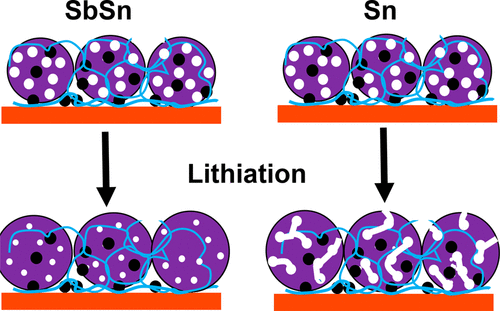Our official English website, www.x-mol.net, welcomes your feedback! (Note: you will need to create a separate account there.)
Understanding Stabilization in Nanoporous Intermetallic Alloy Anodes for Li-Ion Batteries Using Operando Transmission X-ray Microscopy
ACS Nano ( IF 17.1 ) Pub Date : 2020-11-02 , DOI: 10.1021/acsnano.0c03756 Terri C. Lin 1 , Andrew Dawson 1 , Sophia C. King 1 , Yan Yan 1 , David S. Ashby 2 , Joseph A. Mazzetti 1 , Bruce S. Dunn 2, 3 , Johanna Nelson Weker 4 , Sarah H. Tolbert 1, 2, 3
ACS Nano ( IF 17.1 ) Pub Date : 2020-11-02 , DOI: 10.1021/acsnano.0c03756 Terri C. Lin 1 , Andrew Dawson 1 , Sophia C. King 1 , Yan Yan 1 , David S. Ashby 2 , Joseph A. Mazzetti 1 , Bruce S. Dunn 2, 3 , Johanna Nelson Weker 4 , Sarah H. Tolbert 1, 2, 3
Affiliation

|
Tin-based alloying anodes are exciting due to their high energy density. Unfortunately, these materials pulverize after repetitive cycling due to the large volume expansion during lithiation and delithiation; both nanostructuring and intermetallic formation can help alleviate this structural damage. Here, these ideas are combined in nanoporous antimony–tin (NP-SbSn) powders, synthesized by a simple and scalable selective-etching method. The NP-SbSn exhibits bimodal porosity that facilitates electrolyte diffusion; those void spaces, combined with the presence of two metals that alloy with lithium at different potentials, further provide a buffer against volume change. This stabilizes the structure to give NP-SbSn good cycle life (595 mAh/g after 100 cycles with 93% capacity retention). Operando transmission X-ray microscopy (TXM) showed that during cycling NP-SbSn expands by only 60% in area and then contracts back nearly to its original size with no physical disintegration. The pores shrink during lithiation as the pore walls expand into the pore space and then relax back to their initial size during delithiation with almost no degradation. Importantly, the pores remained open even in the fully lithiated state, and structures are in good physical condition after the 36th cycle. The results of this work should thus be useful for designing nanoscale structures in alloying anodes.
中文翻译:

使用Operando透射X射线显微镜了解锂离子电池纳米多孔金属间合金阳极的稳定性
锡基合金阳极由于其高能量密度而令人兴奋。不幸的是,由于在锂化和脱锂期间的大体积膨胀,这些材料在重复循环后会粉碎。纳米结构和金属间化合物的形成都可以帮助减轻这种结构破坏。在这里,这些想法被结合到纳米多孔锑锡(NP-SbSn)粉末中,该粉末通过一种简单且可扩展的选择性蚀刻方法合成。NP-SbSn具有双峰孔隙度,有助于电解质扩散。这些空隙,再加上两种以不同电位与锂形成合金的金属的存在,进一步为缓冲体积变化提供了缓冲。这样可以稳定结构,使NP-SbSn具有良好的循环寿命(100次循环后为595 mAh / g,容量保持率为93%)。Operando透射X射线显微镜(TXM)显示,在循环过程中,NP-SbSn仅扩大了60%的面积,然后收缩至接近其原始大小,而没有发生物理崩解。当孔壁扩展到孔空间中时,孔在锂化过程中收缩,然后在去锂化过程中松弛回到其初始大小,几乎没有降解。重要的是,即使在完全锂化状态下,孔仍然保持开放,并且在第36个循环后结构处于良好的物理状态。因此,这项工作的结果应可用于设计合金阳极中的纳米级结构。
更新日期:2020-11-25
中文翻译:

使用Operando透射X射线显微镜了解锂离子电池纳米多孔金属间合金阳极的稳定性
锡基合金阳极由于其高能量密度而令人兴奋。不幸的是,由于在锂化和脱锂期间的大体积膨胀,这些材料在重复循环后会粉碎。纳米结构和金属间化合物的形成都可以帮助减轻这种结构破坏。在这里,这些想法被结合到纳米多孔锑锡(NP-SbSn)粉末中,该粉末通过一种简单且可扩展的选择性蚀刻方法合成。NP-SbSn具有双峰孔隙度,有助于电解质扩散。这些空隙,再加上两种以不同电位与锂形成合金的金属的存在,进一步为缓冲体积变化提供了缓冲。这样可以稳定结构,使NP-SbSn具有良好的循环寿命(100次循环后为595 mAh / g,容量保持率为93%)。Operando透射X射线显微镜(TXM)显示,在循环过程中,NP-SbSn仅扩大了60%的面积,然后收缩至接近其原始大小,而没有发生物理崩解。当孔壁扩展到孔空间中时,孔在锂化过程中收缩,然后在去锂化过程中松弛回到其初始大小,几乎没有降解。重要的是,即使在完全锂化状态下,孔仍然保持开放,并且在第36个循环后结构处于良好的物理状态。因此,这项工作的结果应可用于设计合金阳极中的纳米级结构。



























 京公网安备 11010802027423号
京公网安备 11010802027423号